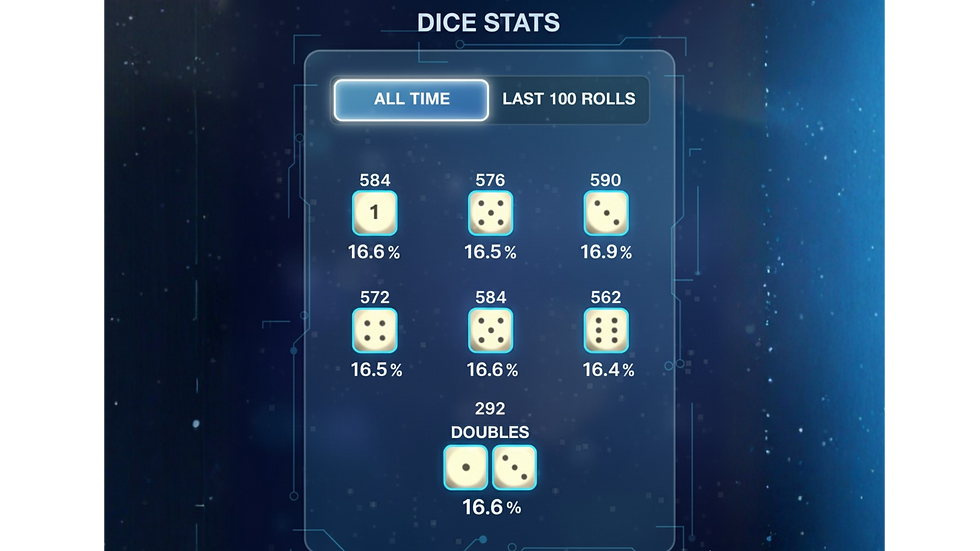Backgammon Dice Probabilities: A Complete Guide to Understanding the Odds
- Matt Hakimi

- Oct 23
- 4 min read

Dice probabilities form the mathematical foundation of backgammon gameplay. While chance plays a role in every match, probability analysis reveals patterns that influence strategic decision-making. This guide examines the essential mathematics behind backgammon dice rolls and explores how probability knowledge affects competitive backgammon play on Backgammon Cash.
Essential Dice Probability Fundamentals
Individual Die Probabilities
Each die in backgammon has six faces, numbered 1 through 6. The probability of rolling any specific number on a single die is 1 in 6, or 16.67%. Over a large number of rolls, each number appears approximately one-sixth of the time.
Total Possible Outcomes
When rolling two dice, there are 36 possible combinations. Though rolling a 3-4 produces the same moves as rolling a 4-3, these count as separate outcomes for probability calculations. This distinction is fundamental to accurate probability assessment.
Double Roll Probability
Doubles (1-1, 2-2, 3-3, 4-4, 5-5, or 6-6) occur less frequently than non-double combinations. With only 6 possible double combinations out of 36 total outcomes, the probability of rolling doubles on any given turn is 16.67%, or approximately once every six rolls.
Specific Roll Combinations
The probability of rolling specific totals varies significantly:
A total of 7 is most common, with 6 different ways to achieve it (combinations include: 1-6, 2-5, 3-4, 4-3, 5-2, 6-1)
Totals of 2 and 12 are rarest, each possible in only one way
Most other totals have multiple pathways, with their probability determined by the number of combinations that produce them
Hit Probabilities by Distance
The likelihood of hitting an opponent's blot varies by distance:
1-6 pips away: Approximately 28-31% depending on exact distance
7 pips away: 17% (6 out of 36 combinations)
8 pips away: 14% (5 out of 36 combinations)
Beyond 12 pips: Probability decreases significantly, requiring indirect shots
Verifying Dice Randomness with Backgammon Cash's Dice Stats
Online backgammon platforms must ensure that each dice roll is truly random to maintain game integrity. The Backgammon Cash team wants our players to be confident that dice rolls in every match are objectively random, which is why we created the Dice Stats feature - on every player's profile.

Players can access their statistics for both all-time dice rolls or last 100 rolls directly from their profile and observe the variance in each number that has appeared. When viewing the last 100 rolls, the data typically shows variance from the theoretical 16.67% average—one number might appear 20% of the time while another appears only 13% over this sample size. This deviation is statistically normal and expected.
The power of the Dice Stats feature becomes evident over extended play. As players accumulate 1,000 rolls, 5,000 rolls, or more, the distribution converges toward expected averages. Each number approaches 16.67%, and doubles appear close to once every six rolls. This convergence demonstrates the law of large numbers and provides verifiable evidence that Backgammon Cash's dice algorithm produces genuinely random results.
The profile-based Dice Stats feature functions as a transparency tool, allowing players to independently verify randomness through their own gameplay data rather than relying solely on platform assurances.
Advanced Strategy: How Probability Influences Strategic Decisions in Real Money Backgammon
Risk Assessment for Exposed Checkers
When a checker is left exposed, the opponent's hitting probability depends on distance. A blot positioned 6 pips from an opponent's checker faces a 31% hit probability, while one placed 7 pips away faces only 17%. This 14-percentage-point difference often determines whether a particular move represents acceptable risk or unnecessary exposure.
Doubling Cube Analysis
Probability analysis plays a central role in doubling cube decisions. Mathematical analysis indicates that accepting a double requires at least a 25% winning probability to be justified. This calculation involves position evaluation, pip counting, and estimating likely outcomes from remaining rolls.
Bear-Off Calculations
During the bear-off phase, probability calculations become more direct. When a player needs a 5 or 6 to clear a checker without leaving a shot, the relevant probability can be calculated precisely. With two dice, the probability of rolling at least one die showing 5 or higher is approximately 56%. These percentages factor into decisions about risk versus conservative play.
Understanding Independent Events
Each dice roll is an independent event. Rolling three consecutive doubles doesn't alter the probability of rolling doubles on the next turn—it remains 16.67%. Similarly, if a particular number hasn't appeared recently, its probability of appearing next remains unchanged. Backgammon Cash's Dice Stats feature illustrates how short-term patterns consistently resolve into expected long-term distributions, providing real-world validation of this probability principle.
The Role of Probability in Competitive Play
Probability knowledge represents a key differentiator in competitive backgammon. While dice outcomes cannot be controlled, understanding probability enables informed responses and systematic decision-making frameworks.
Competitive strategy involves consistently selecting moves that offer the highest probability of favorable outcomes. This means accepting certain risks when odds justify them, declining others when they don't, and basing decisions on mathematical analysis rather than intuition or recent patterns.
Players on Backgammon Cash can observe how probability manifests over time through their profile's Dice Stats, watching as their personal data converges with theoretical expectations. As players develop deeper probability literacy, position evaluation becomes more precise and results become less dependent on short-term dice variance.
Once you've mastered the law of probabilities, you'll have a leg up on your opponents when real money stakes are on the line.





Comments